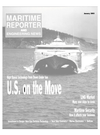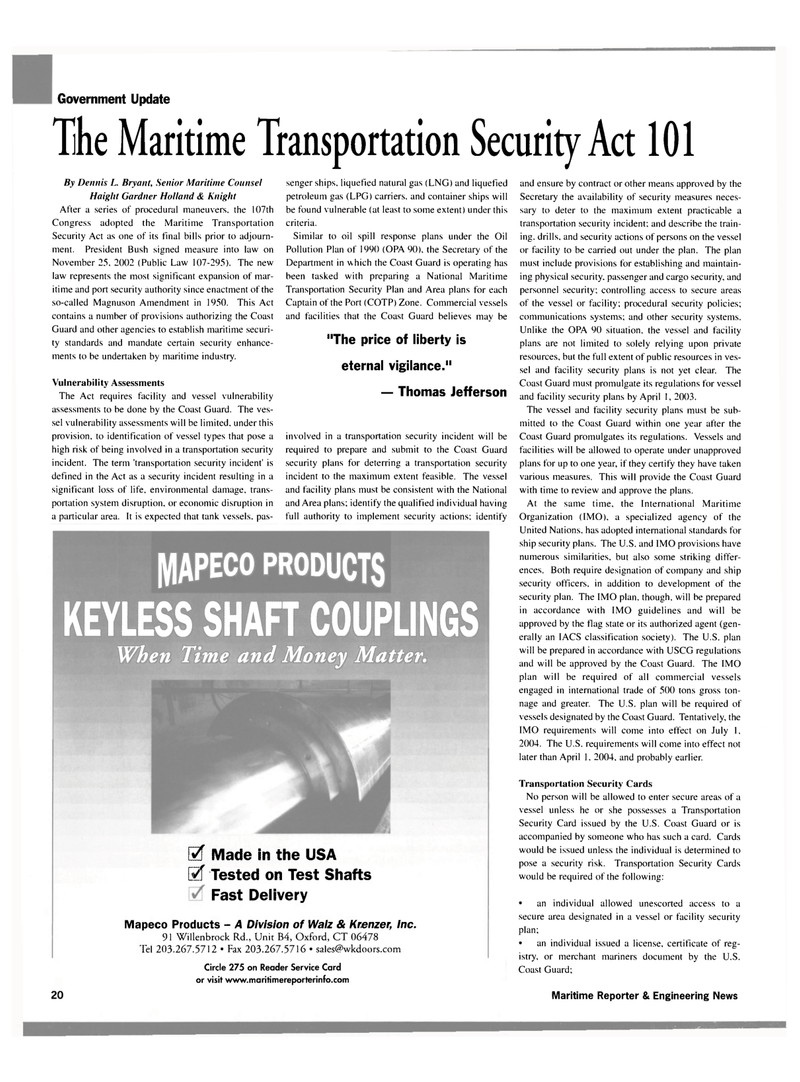
Page 20: of Maritime Reporter Magazine (January 2003)
Read this page in Pdf, Flash or Html5 edition of January 2003 Maritime Reporter Magazine
Government Update
The Maritime Transportation Security Act 101
By Dennis L. Bryant, Senior Maritime Counsel
Haiglit Gardner Holland & Knight
After a series of procedural maneuvers, the 107th
Congress adopted the Maritime Transportation
Security Act as one of its final bills prior to adjourn- ment. President Bush signed measure into law on
November 25, 2002 (Public Law 107-295). The new law represents the most significant expansion of mar- itime and port security authority since enactment of the so-called Magnuson Amendment in 1950. This Act contains a number of provisions authorizing the Coast
Guard and other agencies to establish maritime securi- ty standards and mandate certain security enhance- ments to be undertaken by maritime industry.
Vulnerability Assessments
The Act requires facility and vessel vulnerability assessments to be done by the Coast Guard. The ves- sel vulnerability assessments will be limited, under this provision, to identification of vessel types that pose a high risk of being involved in a transportation security incident. The term 'transportation security incident' is defined in the Act as a security incident resulting in a significant loss of life, environmental damage, trans- portation system disruption, or economic disruption in a particular area. It is expected that tank vessels, pas- senger ships, liquefied natural gas (LNG) and liquefied petroleum gas (LPG) carriers, and container ships will be found vulnerable (at least to some extent) under this criteria.
Similar to oil spill response plans under the Oil
Pollution Plan of 1990 (OPA 90). the Secretary of the
Department in which the Coast Guard is operating has been tasked with preparing a National Maritime
Transportation Security Plan and Area plans for each
Captain of the Port (COTP) Zone. Commercial vessels and facilities that the Coast Guard believes may be "The price of liberty is eternal vigilance." — Thomas Jefferson involved in a transportation security incident will be required to prepare and submit to the Coast Guard security plans for deterring a transportation security incident to the maximum extent feasible. The vessel and facility plans must be consistent with the National and Area plans; identify the qualified individual having full authority to implement security actions: identify
MAPEC0 PRODUCTS
KEYLESS SHAFT COUPLINGS
When Time and Money Matter. 2T Made in the USA
GZf Tested on Test Shafts
Fast Delivery
Mapeco Products - A Division of Walz & Krenzer, Inc. 91 Willenbrock Rd„ Unit B4, Oxford, CT 06478
Tel 203.267.5712 • Fax 203.267.5716 • [email protected]
Circle 275 on Reader Service Card or visit www.maritimereporterinfo.com 20 and ensure by contract or other means approved by the
Secretary the availability of security measures neces- sary to deter to the maximum extent practicable a transportation security incident: and describe the train- ing. drills, and security actions of persons on the vessel or facility to be carried out under the plan. The plan must include provisions for establishing and maintain- ing physical security, passenger and cargo security, and personnel security: controlling access to secure areas of the vessel or facility; procedural security policies; communications systems; and other security systems.
Unlike the OPA 90 situation, the vessel and facility plans are not limited to solely relying upon private resources, but the full extent of public resources in ves- sel and facility security plans is not yet clear. The
Coast Guard must promulgate its regulations for vessel and facility security plans by April 1, 2003.
The vessel and facility security plans must be sub- mitted to the Coast Guard within one year after the
Coast Guard promulgates its regulations. Vessels and facilities will be allowed to operate under unapproved plans for up to one year, if they certify they have taken various measures. This will provide the Coast Guard with time to review and approve the plans.
At the same time, the International Maritime
Organization (IMO). a specialized agency of the
United Nations, has adopted international standards for ship security plans. The U.S. and IMO provisions have numerous similarities, but also some striking differ- ences. Both require designation of company and ship security officers, in addition to development of the security plan. The IMO plan, though, will be prepared in accordance with IMO guidelines and will be approved by the flag state or its authorized agent (gen- erally an IACS classification society). The U.S. plan will be prepared in accordance with USCG regulations and will be approved by the Coast Guard. The IMO plan will be required of all commercial vessels engaged in international trade of 500 tons gross ton- nage and greater. The U.S. plan will be required of vessels designated by the Coast Guard. Tentatively, the
IMO requirements will come into effect on July 1. 2004. The U.S. requirements will come into effect not later than April 1. 2004. and probably earlier.
Transportation Security Cards
No person will be allowed to enter secure areas of a vessel unless he or she possesses a Transportation
Security Card issued by the U.S. Coast Guard or is accompanied by someone who has such a card. Cards would be issued unless the individual is determined to pose a security risk. Transportation Security Cards would be required of the following: • an individual allowed unescorted access to a secure area designated in a vessel or facility security plan; • an individual issued a license, certificate of reg- istry, or merchant mariners document by the U.S.
Coast Guard;
Maritime Reporter & Engineering News

 19
19

 21
21
